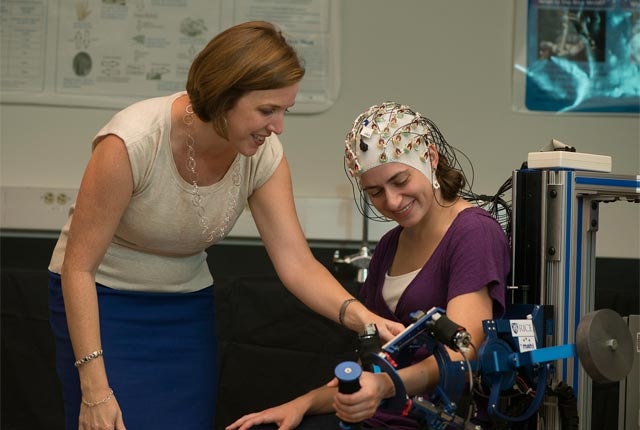Jun 8 2016
Rice University robotics researcher Marcia O’Malley will take her brain-machine interface to Capitol Hill June 9 to take part in a fifth-anniversary celebration of the National Robotics Initiative, a federal initiative to encourage the development of robots that work closely with humans.
 Rice University robotics researcher Marcia O’Malley (left) will take part in a fifth-anniversary celebration of the National Robotics Initiative June 9 on Capitol Hill. (Photo by Jeff Fitlow/Rice University)
Rice University robotics researcher Marcia O’Malley (left) will take part in a fifth-anniversary celebration of the National Robotics Initiative June 9 on Capitol Hill. (Photo by Jeff Fitlow/Rice University)
“Our results are promising,” said O’Malley, professor of mechanical engineering and director of Rice’s Mechatronics and Haptic Interfaces Lab. “We know we can help people who have suffered a stroke. In Washington, D.C., we want to demonstrate our success so we can encourage Congress to maintain this critical funding mechanism for robotics in the U.S.”
O’Malley and her collaborators have developed a robotic orthotic device that revolutionizes upper-limb rehabilitation. The neurotechnology interprets brain waves and makes it possible for stroke patients to operate an exoskeleton surrounding the arm from fingertips to elbow.
O’Malley and collaborators from the University of Houston and TIRR Memorial Hermann received a $1.17 million grant from the National Institutes of Health and the National Robotics Initiative (NRI).
“In most cases, if you want to engage the patient, the robot has to know what the patient is doing,” said O’Malley, the project’s principal investigator. “If the patient tries to move, the robot has to anticipate that and help. But without sophisticated sensing, the patient has to initiate movement.”
Along with roughly a dozen other NRI-funded research groups from around the country, O’Malley will attend an expo, luncheon and panel discussion at the Rayburn House Office Building. Also in attendance will be representatives of the Congressional Robotics Caucus, congressional staffers and robotics researchers seeking to understand the impact of federally funded robotics research.
O’Malley’s lab is developing the robotic exoskeleton, and the UH team is working on the electroencephalograph-based neural interface. The device has been tested by physicians from the University of Texas Health Science Center at Houston on patients who volunteered to try it out at TIRR Memorial Hermann. The exoskeleton is funded through the National Institute of Neurological Disorders and Stroke and is one of a select few projects chosen by the NRI, a collaborative partnership that includes the NIH, National Science Foundation, NASA and the Department of Agriculture.
O’Malley explained that repetitive motion has proven effective at retraining motor nerve pathways damaged by a stroke, but patients must be motivated to do the work. The team led by José Luis Contreras-Vidal, director of UH’s Laboratory for Noninvasive Brain-Machine Interface Systems and a professor of electrical and computer engineering at UH, was the first to successfully reconstruct 3-D hand and walking motions from brain signals recorded noninvasively with an EEG brain cap.
The technology permits volunteers to use their thoughts to control robotic legs, and it enables below-elbow amputees to control neuroprosthetic limbs. The new project is one of the first to design a brain-machine interface system for stroke survivors.
EEG devices translate brain waves from healthy subjects into control outputs to operate the MAHI-EXO II robot developed by O’Malley’s lab. Stroke survivors who have some ability to initiate movements can also prompt the robot into action. This permits the team to refine the EEG-robot interface before moving to stroke patients who do not have residual upper-limb function.
The intelligent exoskeleton uses the patient’s thoughts to trigger repetitive motions and retrain the brain’s motor networks. An earlier version of the MAHI-EXO II developed by O’Malley’s group is already in validation trials to rehabilitate spinal-cord-injury patients at the UTHealth Motor Recovery Lab. That exoskeleton uses feedback that permits patients to work as hard as possible while assisting, and sometimes resisting, motions to build strength and accuracy.
Accompanying O’Malley to the Washington event will be Jennifer Sullivan, a research assistant in mechanical engineering who earned her bachelor’s degree at Rice in 2011 and a master’s degree from the University of British Columbia in 2015.
–Patrick Kurp is a science writer in the George R. Brown School of Engineering.